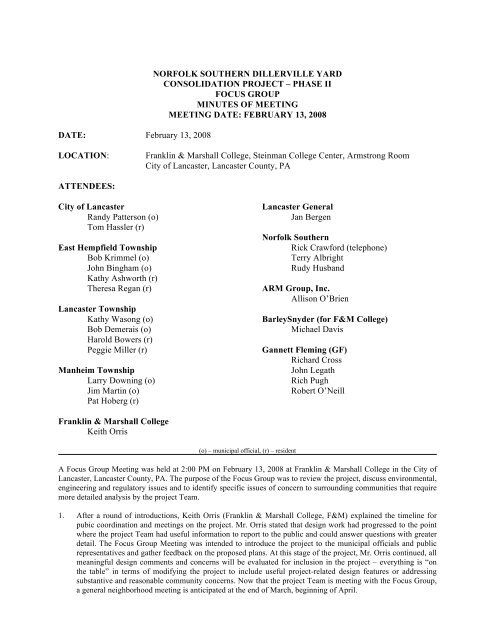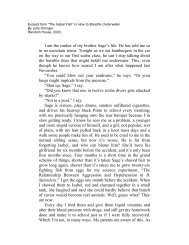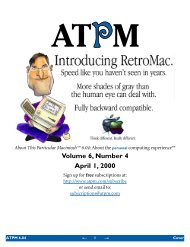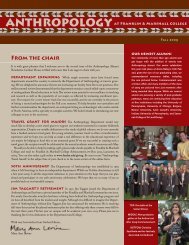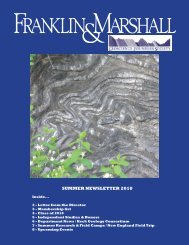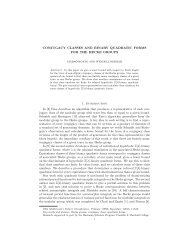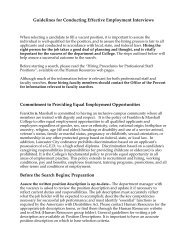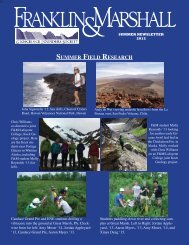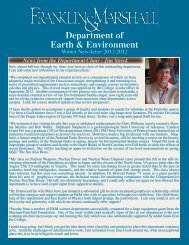norfolk southern dillerville yard consolidation project
norfolk southern dillerville yard consolidation project
norfolk southern dillerville yard consolidation project
- No tags were found...
Create successful ePaper yourself
Turn your PDF publications into a flip-book with our unique Google optimized e-Paper software.
DATE: February 13, 2008NORFOLK SOUTHERN DILLERVILLE YARDCONSOLIDATION PROJECT – PHASE IIFOCUS GROUPMINUTES OF MEETINGMEETING DATE: FEBRUARY 13, 2008LOCATION:Franklin & Marshall College, Steinman College Center, Armstrong RoomCity of Lancaster, Lancaster County, PAATTENDEES:City of LancasterRandy Patterson (o)Tom Hassler (r)East Hempfield TownshipBob Krimmel (o)John Bingham (o)Kathy Ashworth (r)Theresa Regan (r)Lancaster TownshipKathy Wasong (o)Bob Demerais (o)Harold Bowers (r)Peggie Miller (r)Manheim TownshipLarry Downing (o)Jim Martin (o)Pat Hoberg (r)Lancaster GeneralJan BergenNorfolk SouthernRick Crawford (telephone)Terry AlbrightRudy HusbandARM Group, Inc.Allison O’BrienBarleySnyder (for F&M College)Michael DavisGannett Fleming (GF)Richard CrossJohn LegathRich PughRobert O’NeillFranklin & Marshall CollegeKeith Orris(o) – municipal official, (r) – residentA Focus Group Meeting was held at 2:00 PM on February 13, 2008 at Franklin & Marshall College in the City ofLancaster, Lancaster County, PA. The purpose of the Focus Group was to review the <strong>project</strong>, discuss environmental,engineering and regulatory issues and to identify specific issues of concern to surrounding communities that requiremore detailed analysis by the <strong>project</strong> Team.1. After a round of introductions, Keith Orris (Franklin & Marshall College, F&M) explained the timeline forpubic coordination and meetings on the <strong>project</strong>. Mr. Orris stated that design work had progressed to the pointwhere the <strong>project</strong> Team had useful information to report to the public and could answer questions with greaterdetail. The Focus Group Meeting was intended to introduce the <strong>project</strong> to the municipal officials and publicrepresentatives and gather feedback on the proposed plans. At this stage of the <strong>project</strong>, Mr. Orris continued, allmeaningful design comments and concerns will be evaluated for inclusion in the <strong>project</strong> – everything is “onthe table” in terms of modifying the <strong>project</strong> to include useful <strong>project</strong>-related design features or addressingsubstantive and reasonable community concerns. Now that the <strong>project</strong> Team is meeting with the Focus Group,a general neighborhood meeting is anticipated at the end of March, beginning of April.
Waste Management Authority (LCSWMA) used the clay mine site as a depository for municipal trash. Next,the site was bought by Lancaster Malleable and then put up for sale. A developer was considering purchasingthe site but LCSWMA, in a measure to minimize its liability, bought the site to prevent it from beingdeveloped. Later, F&M approached LCSWMA about acquiring the site in order to facilitate relocation ofDillerville Yard and LCSWMA was receptive to the idea. The availability of this land creates space for therealignment and expansion of the Dillerville Yard.6. Q) An attendee asked if the transfer of cars from the Enola Yard to the Dillerville Yard would result inadditional truck traffic in the City of Lancaster.A) Keith Orris explained that the cars brought to the Dillerville Yard from Enola would be reassembled andthen sent out over the rails to customers. The number of customers that come to the Dillerville Yard topick up or off load goods into private trucks would remain the same.7. Q) An attendee asked if the expansion of the Dillerville Yard would generate more truck traffic at therail<strong>yard</strong>.A) The representatives of Norfolk Southern noted that freight rail traffic was predicted to increasesignificantly above its current level in the foreseeable future and they hoped to accommodate that growthin Dillerville. However, it was estimated by NS that 98% of the current customers have their goodsdelivered to their sites by rail, while the remaining two percent (five or six customers) pick up goods at the<strong>yard</strong>. Norfolk Southern does not expect that mix of customers to change. Therefore, if there is an increasein rail freight business over the next 10 to 20 years, they still expect that approximately two percent ofthose customers will come to the site, resulting in a small increase in the number of trucks that access thesite.8. Mr. Orris discussed the <strong>project</strong> timeline. The Dillerville Yard realignment and expansion has been underwaysince November 2007. Prior to that, preliminary studies were completed by Gannett Fleming using PennDOTfunding. Final Design is expected to be completed by the end of March and then the <strong>project</strong> Team will presentthe <strong>project</strong> to the general public. Because federal transportation dollars may be used to fund the <strong>project</strong>, the<strong>project</strong> contract documents may follow the PennDOT Contracting Process. Site work could begin as early asOctober of this year and the overall <strong>project</strong> will take approximately three years to complete. The work isexpected to follow the following phases: construct new <strong>yard</strong> (west of Harrisburg Pike), remodel existing <strong>yard</strong>east of Harrisburg Pike, construct new access road over Harrisburg Pike at which point the old rail <strong>yard</strong> willbe remediated and the local roadway network in Lancaster City will be reconnected and the LGH construction<strong>project</strong> can proceed as planned.9. Rich Cross, Gannett Fleming, described the location studies that were completed when the Dillerville Yardimprovements were first studied. Gannett Fleming examined the Columbia Line between Dillerville andColumbia, Pa to find a 60 acre site for the new <strong>yard</strong>. This is the size of the parcel that would be required tocreate a new rail<strong>yard</strong> from scratch. Only one parcel was identified, the Lime Springs Property in EastHempfield Township, that met this requirement; however this parcel was already slated for development.Therefore, Mr. Cross continued, the only feasible site for realignment and expansion of the Dillerville Yard isat the currently proposed location.10. Q) A question was raised about who regulates Norfolk Southern.A) NS is regulated at the federal level by the Federal Railroad Administration.11. Q) Questions were raised about size of the parcel needed to accommodate the new site relative to the amountof acreage available at the Dillerville Yard.A) A sixty acre site was required because of operational issues; the layout and design of a new facility and allthe supporting features would require an area that large. At Dillerville, all of the necessary facilities are inplace already and would be accommodated by the existing design, including the existing site constraints(total area of approximately 40 acres). Further, a <strong>yard</strong> at Columbia does not meet the need for the <strong>project</strong>.That is, for the <strong>yard</strong> to be viable, it must have access to the Amtrak mainline tracks in order to distribute
goods both locally and regionally. The Columbia Yard is also not capable of being expanded to meet thecapacity requirements of the new <strong>yard</strong>.12. Mike Davis of BarleySnyder, counsel for F&M College, discussed the non-media Solids. The “dump” site iscurrently owned by LCSWMA. Prior to 1955 it was a clay mine, which was used by the brick<strong>yard</strong> for themanufacture of bricks. Between 1955 and 1962 the mine was used as a municipal dump. The site has beeninactive since 1962. Mr. Davis continued that the original plan for the <strong>yard</strong> expansion would require the wastesto remain in place; the dump would be essentially capped with soil. The new plan for this site calls for theremoval of the non-media solids identified in the dump. These wastes will then be characterized according tothe provision of Pennsylvania Act 2 and disposed of accordingly based on testing results, at this time it isanticipated that this waste will go to the LCSWMA landfill for disposal. Clean soil will be imported onto thesite to backfill the waste excavation. All of these activities will be done under the conditions set forth byPADEP and Act 2.13. Q) Will asbestos containing materials be sorted from the waste?A) Mike Davis replied that the wastes would be classified prior to leaving the site and if the material doesn’tmeet the requirements for disposal at the LCSWMA site, they will be sent elsewhere for proper disposal.14. Q) How much waste will be generated for disposal from the landfill?A) Mike Davis responded that the quantity of waste to be generated is not known at this time. Keith Orrisresponded that the quantity of waste generated would be known by the time of the public meeting.15. John Legath, Gannett Fleming, gave an overview of the proposed engineering improvements. The new west<strong>yard</strong> will contain 10 tracks and two light-repair tracks. Small offices and tool and part storage sheds will alsobe present on site. A new bridge over Harrisburg Pike will be built to carry the new NS access road and willaccommodate light trucks. The proposed improvements will be located out of the FEMA 100-year floodplainand the design will be done to meet the township floodplain ordinances and PADEP requirement for NationalPollution Discharge Elimination System permitting.16. Q) What is the elevation of the new site relative to the old site?A) The new tracks will be at approximately the same elevation as the existing tracks.17. Q) What measures will be incorporated into the design to deter trespassing and vandalism?A) No fencing is proposed at the new facility, the facilities in the new <strong>yard</strong> will mirror those in the old <strong>yard</strong>.Norfolk Southern will monitor and patrol the lot as they do their current facility.18. Q) Will the existing rail bridge over Harrisburg Pike be extended to accommodate future additional lanesoftraffic and public access?A) There are no plans to replace the rail bridge over Harrisburg Pike. The fate of existing sidewalks isunknown.[NB – PennDOT was approached early in the <strong>project</strong> about the fate of the NS bridge over Harrisburg Pike andasked if the new structure should be widened to accommodate future traffic growth. PennDOT responded thatthe new bridge should be installed at the width of existing bridges because all bridges must be addressed at onetime for this underpass to be widened and that work was not scheduled.]19. Next, Mr. Legath provided a description of the proposed East Yard Improvements. The tracks that comprisethe existing <strong>yard</strong> will be realigned and moved to a location where there is more advantageous access to theAmtrak lines. The tracks will be parallel to the Amtrak line at this location. The tracks will be widened to meetcurrent railway standard which will result in a reduction in the number of tracks from 12 to 11. Mr. Legath alsoindicated that the existing <strong>yard</strong> office and trestle track will be relocated to the location of the new <strong>yard</strong>; thesefacilities will be replaced in kind, they will not be expanded nor will the new trestle accommodate additional
cars. That is, the new trestle will not result in an increase in the number of trucks that access the <strong>yard</strong>. Threenew engine tracks will be located next to the new storage tracks and these engine tracks will accommodate thesame number of engines as currently use the <strong>yard</strong>. There will not be an increase in the number of enginesoperating in this <strong>yard</strong>.20. Q) If this <strong>project</strong> was not constructed, how would NS expand?A) NS responded that both the existing Enola and Dillerville Yards would be expanded.21. Q) The proposed East Yard is half the size of the existing <strong>yard</strong>, how can capacity be increased in half theamount of area?A) The configuration of the new <strong>yard</strong> will promote more efficient operations, so less area is required to servethe same number of cars.22. Q) How much additional capacity will the new <strong>yard</strong>s provide and how long will it take until full capacity isreached?A) NS responded that they could not predict at what time in the future the <strong>yard</strong> would be at full capacity asthis was determined by actual customer demand.23. Q) How far to the west will the engines travel when shifting cars in the new West Yard?A) The train length will be approximately 20-30 cars longer than existing Enola trains. The majority of theshifting of loaded cars will occur in the east <strong>yard</strong>, while the west <strong>yard</strong> will be used predominately for thestorage of empty cars.24. Q) Have the stormwater management facilities for the east <strong>yard</strong> been designed yet?A) No, but these facilities will be designed to meet the applicable Township Floodplain and StormwaterOrdinances.25. Mr. Legath explained the stormwater collection system and the impoundment. The proposed SWM pond willbe a wet pond with dead storage space that will hold the runoff from a two-year design storm. The pond willalso include an interior berm that will increase the stormwater flow path for sediment removal and will beplanted with a variety of wetland plants that will help to remove soluble and insoluble pollutants from thestormwater. An infiltration pond cannot be used in this location because of the presence of contaminatedgroundwater and Karst topography, the presence of which suggests an increased risk of sinkhole formation.26. Q) Will the stormwater collection system include spill containment features?A) No, not per se; however, because the SWM pond includes dead storage space there is some opportunitythat spills can be contained depending on the type of material spilled and the amount of water in the pondat the time of the spill.27. Q) Will the stormwater collection ditches be lined?A) No, but a lining can be used to make the ditches impervious to infiltration. This suggestion will beconsidered.28. Q) Will these ponds become mosquito breeding areas that promote the spread of West Nile Virus?A) Currently, it is the responsibility of the Townships and the County to monitor and respond to complaintsabout mosquitoes and West Nile Virus concerns. However, the <strong>project</strong> Team will investigate this issue andbe prepared to address it at upcoming public meetings.
[NB - Subsequent investigation of this issue by Gannett Fleming indicates that complaints involving West NileVirus should be direct to the Lancaster County Mosquito Control Coordinator (717-394-6851) at the PennState Cooperative Extension Service for investigation. The Cooperative Extension Service is responsible tomonitor, test and treat waterbodies that contain mosquitos that may transmit the West Nile Virus.]29. Q) Why can’t infiltration ponds be used at this location?A) Even after the non-media solids are removed from the dump, the groundwater beneath the site will remaincontaminated. Infiltrating water at this location would move this contaminated water into the surroundingwaterways more quickly than they are expected to leave the site under existing conditions.30. Rich Pugh of Gannett Fleming provided an overview of the National Environmental Policy Act (NEPA)process and how it applied to this <strong>project</strong>. Mr. Pugh explained that any <strong>project</strong> that used federal funds neededto conform to NEPA. In this instance, part of the federal money dedicated to this <strong>project</strong> is being routedthrough FHWA and the Pennsylvania Department of Transportation administers NEPA on behalf of theFHWA. The NEPA process covers three levels of NEPA actions. Category I Actions require EnvironmentalImpact Statements that typically cover large <strong>project</strong>s where significant adverse effects are anticipated.Category III Actions are covered by Environmental Assessments. Environmental Assessments are used toevaluate <strong>project</strong>s where the degree of impacts to the environment is unknown. Categorically excluded <strong>project</strong>sare NEPA actions where significant impacts to the environment are not expected.In December, a scoping fieldview was held with the FHWA to review existing conditions in the study area andassess the expected level of impact to result from the <strong>project</strong>. Based on the result of the fieldview both FHWAand PennDOT concurred that the <strong>project</strong> could proceed as a Categorical Excluded <strong>project</strong> under NEPA. TheCategorical Exclusion Evaluation is currently under preparation and will be used to catalogue existingenvironmental resources in the study area and evaluate the impacts expected to result from the proposedaction.31. Q) Do Categorical Exclusions involve less study than an EIS?A) Not necessarily. The amount of documentation included in the CEE depends on the number and type ofenvironmental resources present in the study area and the scale of the <strong>project</strong>. All required studies areconducted according to well document PennDOT and FHWA procedures.32. Q) Is a Categorical Exclusion <strong>project</strong> exempt from review then?A) No. Categorical Exclusion documents are reviewed by PennDOT and/or FHWA.33. Robert O’Neill (Gannett Fleming) discussed the types of detailed studies required for the completion of the CEdocument. Three environmental resources categories are considered in the preparation of the CE; natural,cultural and socioeconomic resources are evaluated during preparation of the CE. Natural resources includesuch categories as wetlands, waterways, floodplains, threatened or endangered species, parks, farmlands,hazardous and residual wastes, impacts to homes and businesses, community impacts, secondary developmentimpacts, impacts to archaeological and historic sites, etc. On this <strong>project</strong>, detailed air, noise and vibrationanalysis will be conducted because of the concerns expressed by the public about these issues.Further, in addition to the need to comply with NEPA, PennDOT is required to comply with two otherregulatory statutes: Section 4(f) of the U.S. Department of Transportation Act and Section 106 of the NationalHistoric Preservation Act. Section 4(f) requires avoidance or minimization of impact to Section 4(f) resourcessuch as historic sites, wildlife refuges, parks, national forest, public recreation areas, etc. Section 106 governsthe identification of historic structures and archaeological sites and the impacts to those resources. These twoprograms run in parallel to NEPA and must be included in the NEPA document. Mr. O’Neill emphasized thatthe level of documentation required for Section 4(f) and Section 106 is exactly the same level of analysisrequired for a <strong>project</strong> whether a CE or an EIS is being prepared.34. Q) Will the studies conducted for the CE include regional as well as local issues?
A) Regional issues may be considered depending on the resources present in the study area. For example, thestudy area used for the noise or air analysis will be much larger than the study area assessed for wetlands.35. Q) Will the CE include an evaluation of “Quality of Life” issues?A) Yes, the CE includes consideration of such issues as traffic, impact to emergency services, impacts tocommunities and local business, etc. Noise and air studies will be conducted to address communityconcerns about these issues.36. John Legath discussed the lighting for the proposed <strong>yard</strong>. Mr. Legath described the lighting that will bespecified for this <strong>yard</strong>. High-mast lighting similar to that used at highway interchanges is not going to be usedon this <strong>project</strong>. Instead, low-mast lighting about 35-feet high will be placed at switch locations and at 125-feetspacing along the NS access road. No lighting will be placed to the west of Little Conestoga Creek.37. Mike Davis of BarleySnyder discussed the Rail Regulatory Process. Norfolk Southern is subject to federalregulation by the Surface Transportation Board and the Federal Railroad Administration. On this <strong>project</strong>, NSwill use its power of eminent domain to acquire the property for the west <strong>yard</strong>. NS will not be entering into anykind of lease agreement with LCSWMA.38. Q) Why is NS using eminent domain instead of negotiating with LCSWMA to acquire property.A) Acquiring this property using eminent domain is easier for NS; they can acquire only the land theyneed/want for proposed rail improvements. LCSWMA will be paid fair market value for the land acquiredand the transaction will be considered a “friendly take.”39. Q) What governs the use of eminent domain?A) Federal statutes govern a railroad's eminent domain power and the federal court systems has jurisdiction toadjudicate disputes arising from the use of this power.40. Q) Will this <strong>project</strong> be subject to Township Zoning Ordinances?A) No.41. Norfolk Southern discussed the current <strong>yard</strong> operations. The Dillerville <strong>yard</strong> currently handles 13 trains perday; this includes eight trains for local deliveries plus five <strong>yard</strong> trains. Additionally, the Enola-Dillerville trainmakes deliveries to Dillerville and takes empty cars back to Enola during the return trip. The Enola-Dillervilletrain arrives at Dillerville between 5:00 – 8:00 AM and leaves for Enola at 11:00 PM. The Enola-Dillervilletrain is approximately 110 cars long. The local trains that are assembled at Dillerville and make deliveries viathe adjacent Amtrak lines run at regular intervals: 5:30, 7:00 and 11:00 AM and 6:30, 7:30, 8:30 and 11:30PM. This schedule is determined by Amtrak’s operations and these are the times when NS trains are permittedto run on Amtrak lines.Operations in the new <strong>yard</strong> will be very similar. No new locomotives will be added and no new local trainswill be added. However, the Enola train and the local trains may be longer, depending on business. The <strong>yard</strong>will continue to handle two trains from Enola but no more than that. The Dillerville Yard will be capable ofoperating 24 hours per day, but the existing delivery schedule is not 24 hours a day and should not change.Currently, traffic is heaviest Monday through Friday and drops off substantially on weekends.Current commodities handled in the Dillerville Yard include paper, grain, aluminum, steel, wood, plastic andsome hazardous materials. While NS is conscious of community concerns regarding hazardous materials, theyare required to transport these materials if customers ask them to. Cars containing hazardous materialsgenerally do not stay in the <strong>yard</strong> for long; they are moved as soon as possible after arriving. No car containinghazardous material may remain in the <strong>yard</strong> for more than 48 hours. The Norfolk Southern officials stressed thecommitment to safety the company has made and indicated that the Dillerville Yard is one of the safest <strong>yard</strong>sin the Harrisburg Division. Norfolk <strong>southern</strong> is committed to protecting its employees and surroundingcommunities. Demand for NS transportation stems from providing safe, efficient operations at a fair price.
42. Q) Will the amount of hazardous material handled in Dillerville Yard increase due to the <strong>yard</strong> expansion.A) No, the quantity of hazardous material handled is based on demand for these products. If demand remainsflat, the number of cars carrying hazardous materials will not change.43) Q) Will noise increase due to increased number of cars processed?A) Operations will remain essentially the same except local trains may be longer. Most activity will remain inthe east <strong>yard</strong>, the west <strong>yard</strong> will used primarily for the storage of empty cars. This added storage capacityshould minimize the disruption to traffic at the Farmingdale Road crossing.44) Q) Will the increased efficiency of the proposed <strong>yard</strong> mean fewer locomotives will be used?A) That’s a possibility. The number of engines required to move freight within and out of the <strong>yard</strong> has beendecreasing steadily, therefore future reductions in the number of engines are possible.45) Norfolk Southern gave a brief description of its current locomotive fleet. The engines they are using inDillerville are state of the art engines that do not have to idle 24-hours per day; they incorporate newtechnology that allows them to shut down automatically while maintaining critical engine functions andheating engine fluids.46) Currently, the NS engines that do idle are located at the engine tracks near the <strong>yard</strong> office off HarrisburgPike. When the east <strong>yard</strong> is remodeled, the engine tracks will be located further away from HarrisburgPike. The engines are fueled at the engine tracks by an off-site vendor in a delivery truck.47) Q) A statement was made that the NS trains are currently idling near Farmingdale Road and the neighborshave been complaining about this.A) Norfolk Southern responded that, yes, sometimes, depending on train length, engines will idle in thatlocation. Norfolk Southern has made changes in its operation to try to avoid that situation. For example,NS has asked it’s engineers to stop short of the Bridge over the Little Conestoga Creek whenever possibleto avoid community disruptions. Unfortunately, this cannot always be avoided. The new <strong>yard</strong> will help toeliminate this situation. Terry Albright, <strong>yard</strong> master, said that he has instructed his engineers not to idleeast of the bridge and if any residents see otherwise they should call him.48) Q) What types of repairs are made at the rail <strong>yard</strong>?A) Light repairs only, operations like brake, wheel and hose replacements, lubrication of parts, etc.49) Q) What is the potential for spills or other types of releases associated with these repairs?A) The maintenance activities conducted in the <strong>yard</strong> are not dissimilar from basic automotive repairs. Thechance of large-scale spills or contamination due to engine maintenance is small. With the advent ofcleaner, more efficient, newer engines, concerns with spills or releases will also diminish.50) Q) How big of a problem is trespassing and personal safety in the <strong>yard</strong>?A) NS indicated that they have no problems with vandalism or trespassing at the current site. The <strong>yard</strong> is notfenced because fences are easily avoided and breached by those intent on trespassing. All train crewsworking in the <strong>yard</strong> are trained to look for potential problems and safety issues. This <strong>yard</strong> does not containany cameras; cameras are typically reserved for use in areas with known problems or high-valuecommodities.51) Q) Since most of the communities surrounding the <strong>yard</strong> have volunteer emergency services with limitedresources; will NS contribute funds to local communities for emergency services?
A) Yes. Small requests for assistance can be channeled through the NS Regional Office. Larger requests forgrants can be channeled through the NS Foundation. Township Officials were encouraged to go to thecommunity page of its website at www.nscorp.com.52) Q) Do most hazardous material releases occur during switching of cars?A) No. Most hazardous material releases occur due to improper filling of cars, not because of improperhandling. All cars containing hazardous materials in Dillerville Yard are handled using locomotives to putthem into position, they are not simply allowed to crash into each other when joining them together as partof train assembly.55) Q) How is the <strong>project</strong> being funded?A) According to Mr. Orris, the construction estimate for the <strong>project</strong> is approximately 40 million dollars. Thesources of this funding include (approximately) 14 million dollars in private investment (NS, LG andF&M); The remaining funding will be from a variety of state and federal funding sources.56) Q) How will remediation of the landfill be paid for?A) This will be covered in the overall <strong>project</strong> funding, but it is not known from which pool of funds themoney will come from at this time.57) Q) What will happen to the Baker Campus and Brick<strong>yard</strong> Properties as a result of this <strong>project</strong>?A) Franklin & Marshall has commissioned a study to identify the potential uses of both the Baker Campusand the Brick<strong>yard</strong> Properties. This study will account for the existence and types of the communitiesadjacent to the site.58) The public meeting scheduled for early spring was discussed. It will probably be held in the Alumni Sport andFitness Center on a weekday evening. Letters of invitation will be mailed out. A list of Frequently AskedQuestions will be developed to help answer community inquiries “up-front”. F&M is considering using aprofessional facilitator to help address questions and resolve conflicts. A website is also being considered tohelp disseminate <strong>project</strong> information to the public.59) Q) A statement was made that the public meeting planned for the spring should follow the “PennDOT”format.A) This style of public meeting can be used. Norfolk Southern indicated that they follow a similar format toPennDOT.The meeting was adjourned at approximately 5:00 pm.These minutes represent our best interpretation of the proceedings of this Project meeting. If you have questions orrequire additional information, please contact Robert P. O’Neill at 610-650-8101.c: File 47720All AttendeesRobert P. O’Neill


